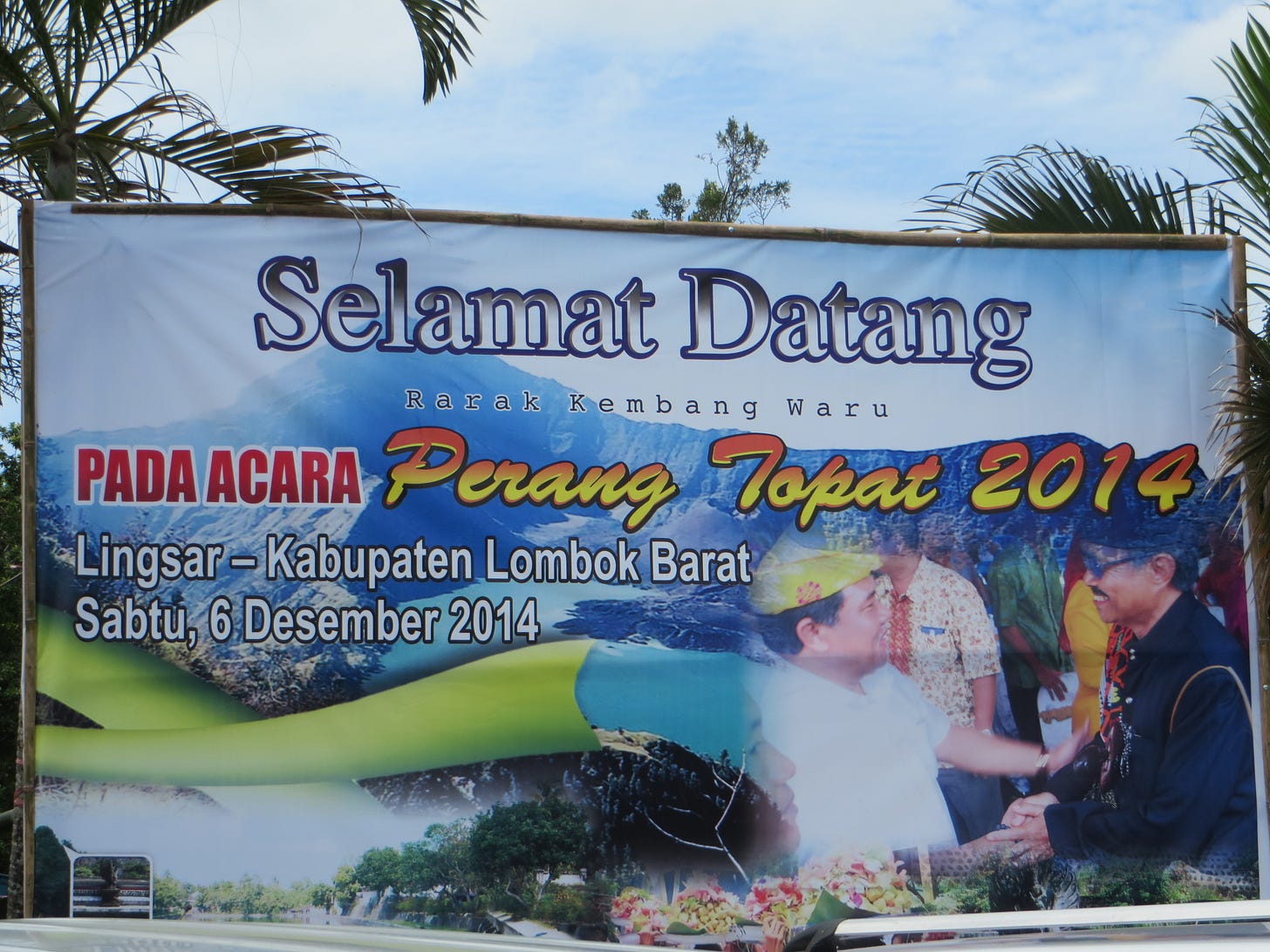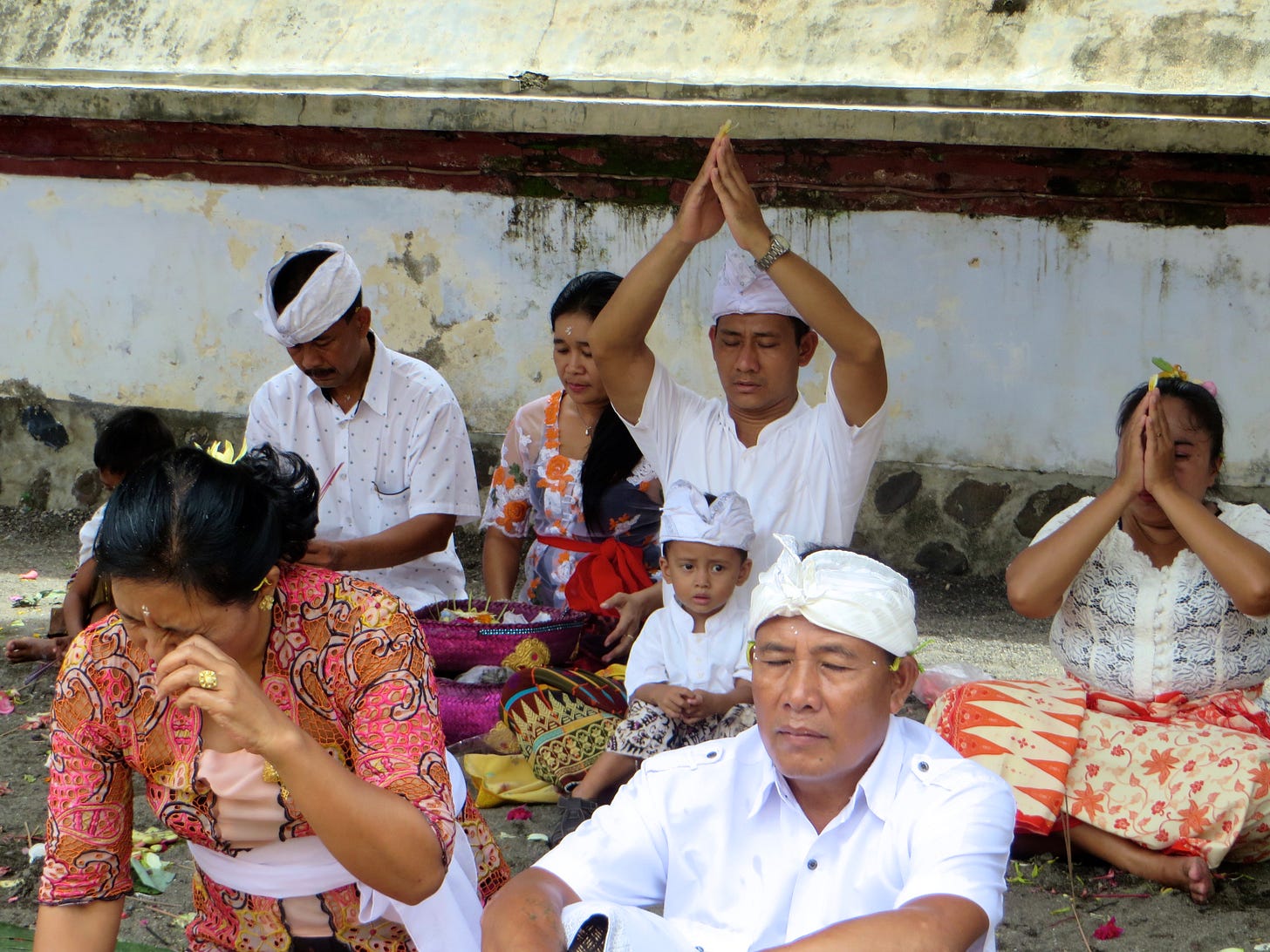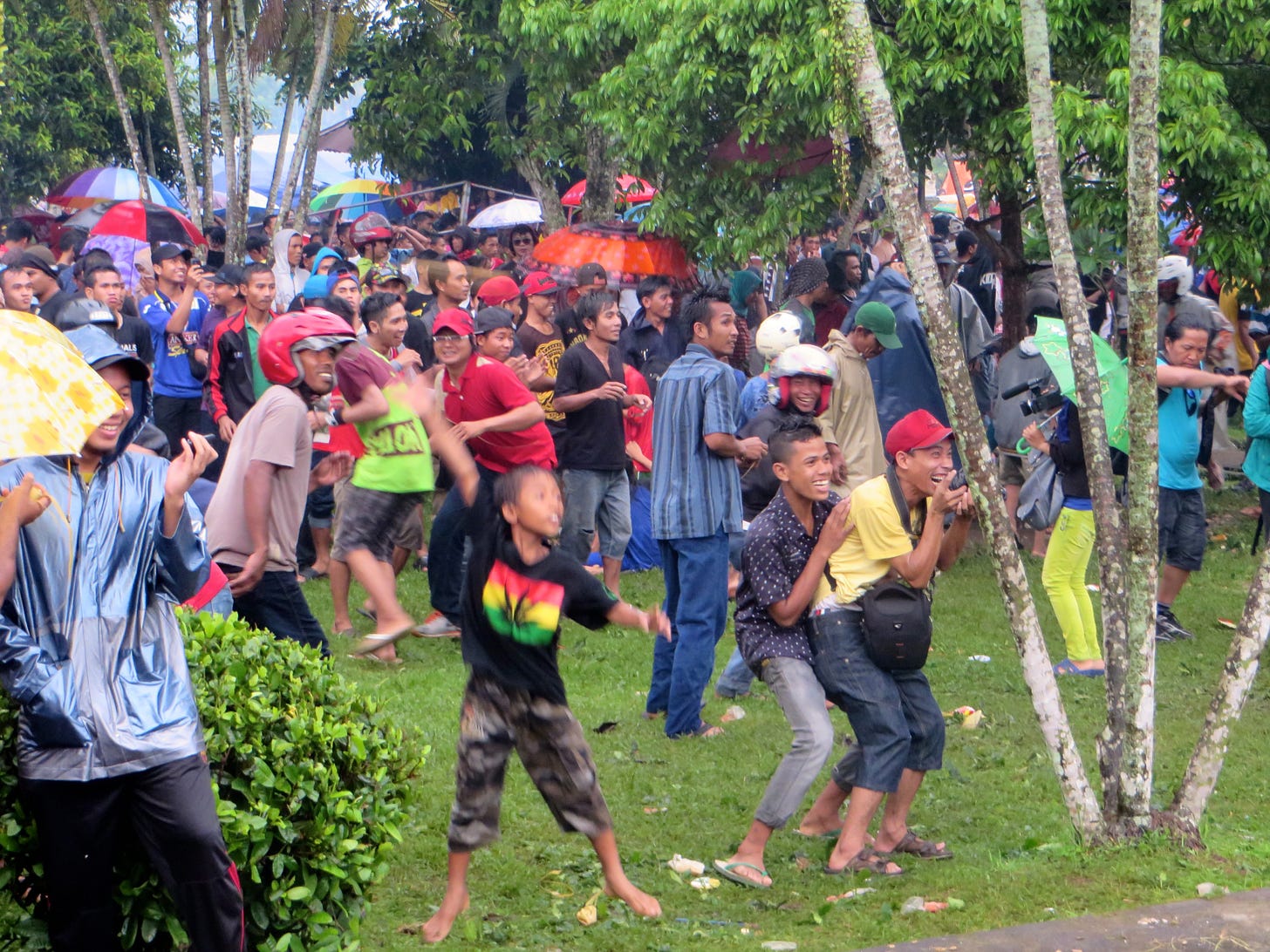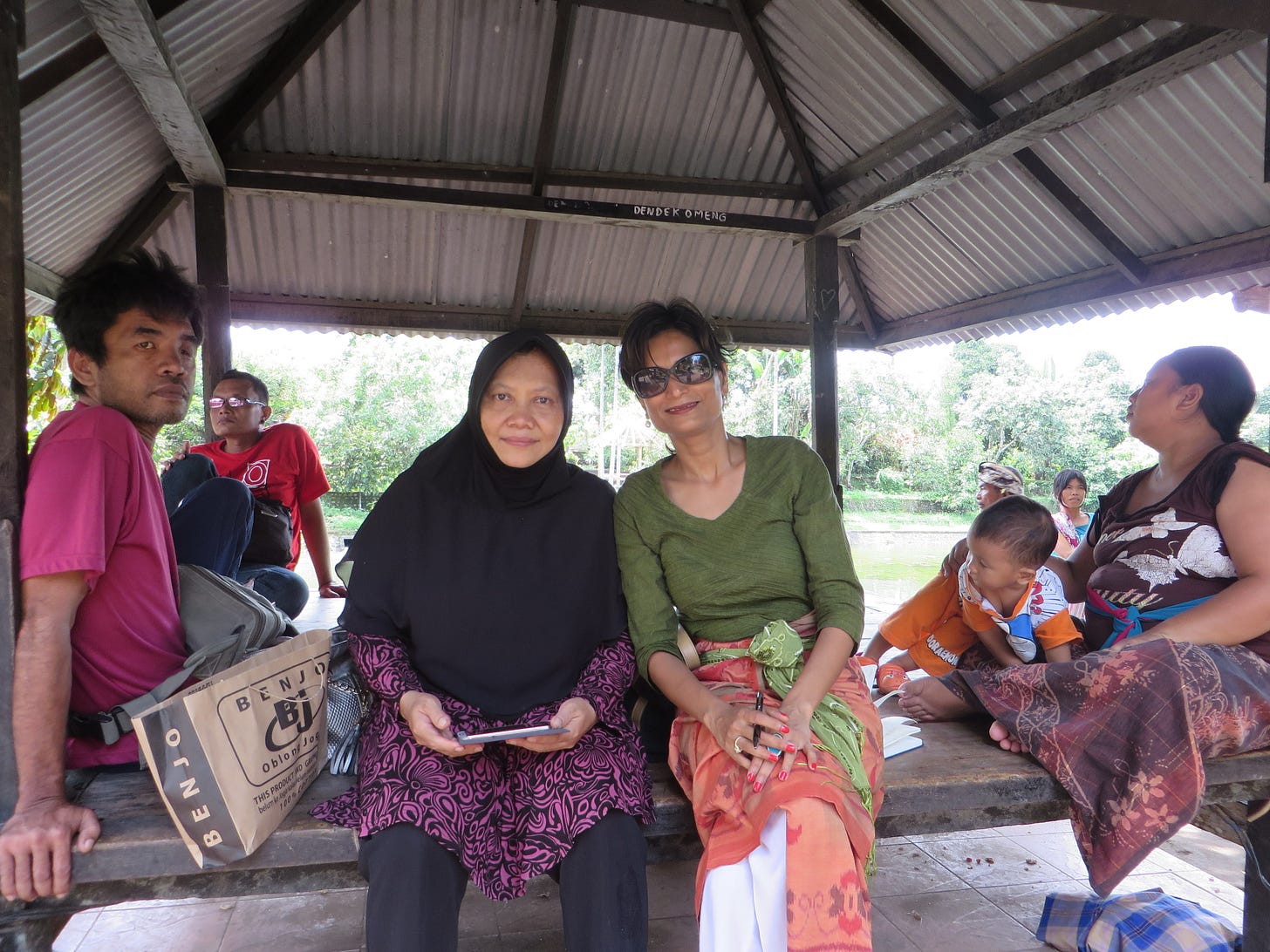The social complexity of a food fight in Indonesia
Hindus and Muslim hurling rice cakes at each other highlights achievements, confusions and contradictions of a multicultural society.
Selamat pagi/siang/sore, my time zone-dispersed friends:
The Global Jigsaw is a celebration of the cocktail - shaken or stirred. We like our world jumbled up despite the complexity that confluence entails. Purity might be easier, but the cognitive monoculture it engenders is always dull and often dangerous.
Among the gamut of mish-mashy places that I’ve lived in, Indonesia deserves pride of place for its syncretism. An archipelago, comprising 17,000 islands, its storied history layered with animist, Hindu-Buddhist, Chinese and Islamic influences, makes it a compelling case study for studying the confusions, contradictions and challenges of a multicultural society.
For this week’s post I invite you to join me at a food fight on the Indonesian island of Lombok that gave me both cause for hope and despair. Do read and don’t forget to tell me which one you think trumps in the end.
Now, this is not some ideological food fight about whether the popiah/lumpia rightly belongs to Malaysia or Java, but a literal one, involving two groups of people throwing food at each other. It takes place in the Purl Lingsar temple complex, amid the green-gold paddy fields of western Lombok, an island of some 3 million people just east of Bali that is home to the predominantly Muslim, Sasak people.
I visited there on a December morning a few years ago. To my bemusement, a billboard framed the temple entrance, depicting a soldier in dark glasses shaking hands with a portly civilian, against a backdrop of mountains and, mysteriously, a giant hosepipe.
Billboard at entrance to Puri Lingsar. Pic credit: Pallavi Aiyar
Inside the grounds, traditional gamelan orchestras clanged away and hundreds of devotees crowded into the Kemaliq, a courtyard built around a sacred pool. Some sat with their palms joined and raised above their heads, in the gesture typical of Hindu worship. Others adjusted their prayer mats to face towards Mecca. Many women were dressed in kebayas—tight-fitting blouses, worn with a sash and a sarong—while others wore hijabs.
Devotees praying in the Kemaliq. Pic credit: Pallavi Aiyar
Late in the afternoon, the dignitaries arrived. One of them, a man in military fatigues and accompanied by a large entourage, stood inspecting the scene. He was the temple’s Sasak Muslim pemangku, or supervisor, I was told. I recognized him from the billboard. Nearby, I spotted the fleshy civilian from the billboard too—Zaini Arony, the local bupati, or elected government representative.
The sky had been darkening for a while, and it began to rain. Even so, an hour of traditional dances followed, chased by a round of speeches.
At one point, the master of ceremonies announced the presence of a special guest from India—me. “You can identify her by her big nose,” he said. A young policeman sidled up to me. “Are you Hindu?” he asked. I nodded. “So am I,” he said, his body language immediately more relaxed. “Can you tell me why you treat women so badly?” Local Hindus, he said, were embarrassed “because people keep saying Hindus rape and beat women after reading the news about India.” I was spared having to answer by a call from the bupati for the fighting to begin. A roar filled the air, and the crowd started flinging about gobs of sticky rice.
Perang topat in full swing. Pic credit: Pallavi Aiyar
I was witnessing, the perang topat, literally - rice cake war. This is an annual ritual dating to the mid-19th century, wherein Balinese Hindus and Sasak Muslims take good-natured aim at each other with balls of boiled rice stuffed into woven coconut leaves. The event is part of Pujawali, a five-day festival that falls in late November or early December (depending on the lunar calendar).
During Pujawali, thousands of Hindus and Muslims gather to worship together at Puri Ligsar, a striking symbol of Indonesia’s fabled syncretism. But there’s more complexity to the festival than just inter-communal feel-good jousting.
On Lombok, Hindus and Muslims harbour prejudices against each other that are rooted deep in the island’s past. Hindus from Bali ruled Lombok from 1740 to 1894, when they were replaced by Dutch colonialists. At present, political power lies with the Sasak majority, and only a tenth of Lombok’s inhabitants are Balinese Hindus. But Sasak resentment against Balinese domination survives.
Moreover, there is also rising disagreement between Lombok’s Muslims over the unorthodox celebrations at Puri Lingsar. This schism is exacerbated by the surge of conservative Islam across Indonesia since the fall, in 1998, of a dictatorship that kept religion relatively separate from public life. In recent years, there’s been widespread mosque building on the island and the local government promotes Lombok as “the land of 1000 mosques.
Perang topat then, represents a peculiar mix of tolerance and suspicion, agreement and discord. Its meaning is messy, as lived reality in multicultural societies usually is. (Especially messy given the gobs of sticky rice being flung about!)
On the day I attended, the food fight lasted about a quarter of an hour before a policeman’s whistle signaled the end. The bupati had already departed, having thrown a single symbolic rice cake towards no one in particular.
I then had a chance to explore the temple further. I learned that Puri Lingsar had two pemangku, one Hindu and one Muslim, who ran their affairs independently. Each community also had its own ritual orchestra, and during my visit they appeared to be competing to drown each other out. Hindus and Muslims prepared their celebratory meals for Pujawali in separate compounds.
As I made my way to the inner sanctum, of the Kemaliq, I noticed buffalo carcasses hanging from a wall. My guide - Nyoman Sumantri, a Balinese Hindu professor of law—explained that cows are not slaughtered at the temple, because although there is no prohibition on eating beef amongst the Balinese, neo-Hinduism imported from India is an ongoing phenomenon. Buffaloes are a safe bet to slaughter since they are exempt from the cow’s holy status. Eating them is non-offensive to all concerned. On the day of my visit, three animals had been ritually butchered in a halal manner and shared out amongst the worshipers, both Hindu and Muslim.
Offerings of betel leaves and lime, covered with multi-coloured flowers were laid out at the doorways to the various shrines, as were glass bottles filled with fermented palm liquor.
Temple offerings at Puri Lingsar. Pic credit: Pallavi Aiyar
Watching the lines of devotees stream into the Kemaliq, it was difficult distinguishing between Hindu and Muslim. The only tell-tale sign was that Hindu women tended to have flowers in their hair, whereas many of the Muslim women wore headscarves.
Within the courtyard, a raised platform covered with a thick white sheet functioned as a shrine. Hindus heaped the right-hand part with mounds of offerings and the Sasak Muslims did the same to the left. Just a wooden pole divided the two sides.
Worshipers in the Kemaliq. Pic credit: Pallavi Aiyar
*****
Pujawali is promoted by the local government as a tourist attraction and touted as a unique example of inter-religious harmony. And it is. But the truth is rarely as unqualified as a tourism board slogan. “Harmony” in this case, is a rhetorical gloss over the multiple fractures of religion, ethnicity and history.
My guide, Mr. Sumantri, had warned me at the outset to watch my wallet in the swirling crowds. “Be careful around these Sasak (Muslims),” he’d said nonchalantly.
With my guide, Mr Sumantri.
Later, I met with Erni Budiwanti, a middle-aged, hijab-shrouded academic from Jakarta whose research focuses on the Lingsar festival. “They (the Hindus) say the Sasak steal, that they do not have good characters,” she’d said with a resigned shrug.
With Jakarta academic, Erni Budiwanti.
Lombok’s Hindus and Muslims agree that Puri Lingsar is sacred because of the springs feeding “holy” water into the Kemaliq pool. Agreement ended there.
The Balinese claim the springs were created, in the mid-eighteenth century, by a Hindu deity, Batara Gede Lingsar. The Sasak, however, hold that the springs originated in the fifteenth century, after Datu Wali Milir, a Muslim preacher credited with spreading Islam in Lombok, struck the earth at this spot with his wooden staff.
Other disagreements:
The island’s Muslims fall into two broad categories: the Waktu Lima and the Waktu Telu. The former follow a reformist, orthodox Islam and pray five times a day (lima is “five” in the local language). The Waktu Telu pray thrice a day—telu is “three”—and have retained elements of their pre-Islamic culture.
Nearly all the Muslims who participate in Pujawali are Waktu Telu. The majority of Sasak were Waktu Telu once, but their numbers have shrunk to some 40,000. As a result, the number of Sasak Muslim worshippers at the festival is also in decline. Many Islamic leaders today, pointedly advise their congregations to stay away from perang topat.
Still, the Waktu Telu have particular reason to attend. They are overwhelmingly farmers, with livelihoods closely tied to water and fertility. And Pujawali also functions as a harvest festival. Before the Waktu Lima iteration of Islam spread, both Sasak Muslims and Balinese Hindus shared a culture of water worship. The Lingsar temple controls irrigation networks in the surrounding area. (Once I learned this, the hosepipe on the billboard at the temple entrance suddenly made sense.)
*****
During the festivities, I met with the Balinese pemangku, Ikatut Linga Bagiyarta. He offered me some buffalo and rice, before launching into a lengthy soliloquy about the harmony between the island’s Hindu and Muslim communities. Though it was difficult to edge in a question through the PR babble, I was eventually able to slip in one about the Sasak version of the founding of Lingsar. What did he think of the Muslim claim that the springs at Puri Lingsar predated the arrival of the Balinese on the island?
Bagiyarta’s jaw tightened. “People can say whatever they want,” he replied, his loquaciousness at an abrupt end.
Balinese pemangku, Ikatut Linga Bagiyarta. Pic credit: Pallavi Aiyar
*****
The Lingsar festival raises many imponderables. It brings together an erstwhile ruling elite, the minority Balinese Hindus, and a Sasak Muslim majority who in a reversal of historical fortunes are the contemporary wielders of political power. It also highlights the contradictory tendencies of a government simultaneously promoting adat (pre-Islamic customs) and a reformist Arab-oriented agama (religion) cleansed of indigenous traditions. Those who come to Lingsar to worship are both tolerant and suspicious of each other. In this curious admixture, Puri Lingsar is a microcosm of modern Indonesia.
And despite its contradictions, I believe the situation there to be better off than in India, where Hindus and Muslims are busy hurling genocidal threats at each other. Rice cakes would be far preferable.
*****
Dear reader, please do subscribe to the Global Jigsaw. And as usual, share this post and others. I appreciate it greatly.
Hasta pronto,
Pallavi
A version of this article first appeared in The Caravan magazine.












This was most interesting Pallavi! Indonesia is full of lore I can never get enough of. And your take on these are so insightful.
Fascinating tradition, and very smart the Londok people fighting out their religious arguments with rice cakes...